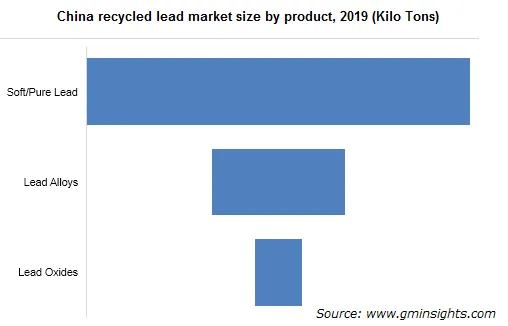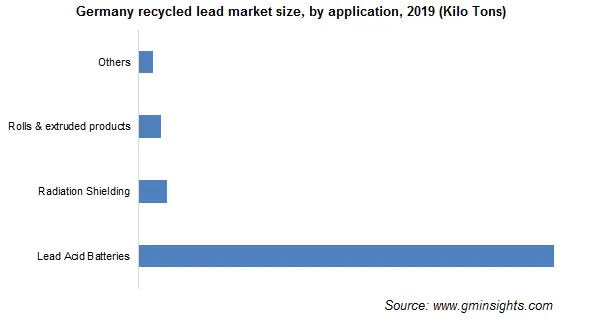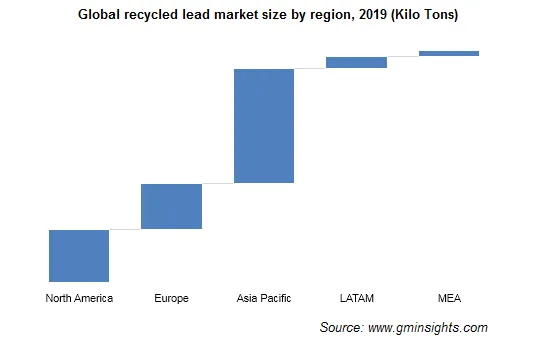


Recycled Lead Market
Get a free sample of this report
Your inquiry has been received. Our team will reach out to you with the required details via email. To ensure that you don't miss their response, kindly remember to check your spam folder as well!
Form submitted successfully!
Error submitting form. Please try again.

Request Sectional Data
Your inquiry has been received. Our team will reach out to you with the required details via email. To ensure that you don't miss their response, kindly remember to check your spam folder as well!
Form submitted successfully!
Error submitting form. Please try again.
Recycled Lead market size was USD over 15.0 billion in 2019 and shall exhibit gains of over 3.5% CAGR throughout the forecast timespan. Widespread product applications in industries such as energy, transportation, data centers, electronics, construction, and healthcare will dictate the industry’s growth over the forecast timeframe.

Recycled lead or also commonly called as secondary lead is extracted from components containing lead such as lead acid batteries, cable sheathings, lead sheet boards, pipes, and plumbing articles, etc. Globally, lead has the highest recycling rates, better than common recyclable items such as glass, newspaper, paper and cardboard, rigid plastics/bottles etc.
| Report Attribute | Details |
|---|---|
| Base Year: | 2019 |
| Recycled Lead Market size in 2019: | USD 15 Billion |
| Forecast Period: | 2020 to 2026 |
| Forecast Period 2023 - 2032 CAGR: | 3.5 |
| 2023 Value Projection: | USD 19 Billion |
| Historical Data for: | 2016 to 2019 |
| No of Pages: | 181 |
| Tables, Charts & Figures: | 256 |
| Segments Covered: | Soft/Pure Lead, Lead Alloys, Lead Oxides, Lead Acid Batteries, Radiation Shielding, Rolls & Extruded Products, Energy, Transportation, Data Centers, Electronics, Construction, Healthcare |
| Growth Drivers: |
|
| Pitfalls Challenges: |
|
As per the International Lead Association, nearly more than 50% of the global lead demand is sourced from recycled lead. It is mainly due to the simple production and cost-efficient nature of recycled lead, coupled with the lowering number of lead mining due to depleting lead ore and increasing regulation of lead mining.
The major source of lead recycling is lead acid batteries, where every component is separated, lead is processed and converted into various forms for further applications.
Lead is known for its excellent properties such as corrosion resistance, excellent malleability, and soft texture. Along with these properties recycled lead market has decent size to weight ratio, making it appropriate for various industrial applications such as electronics, construction, paints & coatings, petroleum, etc.
However, its toxic nature has found to have equally serious health concerns for children and adults. Hence, in recent times, lead use in petroleum and paints & coatings for public and private construction has been phased out in the majority of countries. Additionally, lead scraps are hazardous waste and their unsafe disposal results in grave environmental & health problems.
Methodical and proper lead recycling from scraps results in less solid waste and consumes over 35% lesser energy and reduces the consumption of minerals than lead production from ores.
One of the important hindrances to the growth of the recycled lead market will be the continued unregulated lead recycling and growing demand for lithium-ion technology. Lead recycling is a simple process that can be carried out in limited space and with lesser tools, which is a common practice in developing counties such as China, India, Malaysia etc.
Such practices possess greater health risks to the involved workers & the surrounding environment, thereby affecting the lead recycling industry.
With proper streamlining of lead scrap processing, use of essential smelting equipment and lead-acid batteries infrastructure, the recycled lead market will observe a speedier growth over the forecast period. On the other hand, recycled lead is largely driven by the use of lead-acid batteries, that are largely used in automobiles, owing to its low cost and longer shelf life.
However, lithium-ion batteries are also rapidly becoming a stronger choice as replacement of lead acid batteries due to their lowering price and increasing capacity. Nevertheless, the growing capacity of lead-acid batteries at lower is expected to continue its share in the battery market, thereby driving demand for the secondary lead over the forecast period.

The product segment of the recycled lead market is segregated into soft/pure lead, lead alloys, and lead oxides. In 2019, soft/pure lead held the largest share of over 65%, as it is the primary refined product of lead recycling and is largely used as a raw material in lead-acid battery production.
Lead alloys and oxides are further produced using pure lead. The three product types are largely differentiated on the basis of their respective properties. Various elements such as copper, silver, indium, tin, calcium etc. are added to pure lead resulting in high strength alloys, that are further used as anti-corrosive sheets in marine and construction industries

Applications of recycled lead are segmented into lead acid batteries, radiation shielding, rolls & extruded products, and others. The other segment includes paints & coatings, ammunition, etc. Lead-acid batteries occupy the highest share of over 80% of the recycled lead market. The recycled lead used in the production of lead acid batteries is fully recyclable and recoverable.
Other than lead acid batteries, secondary lead is processed, cast and rolled into various forms such as ingots, sheets, wires, billets, for further industrial uses. Among the rolls & extruded products, recycled lead wires are used in the soldering of electronic equipment.
Lead tin and lead copper alloys are extruded for use as a pipe in various industries. Extruded lead pipes are used for carrying acids and corrosive chemicals or for sheathing sensitive communication cable runs for waterproofing purposes.
The global market is further segmented as per its usage in industries such as energy, transportation, data centers, electronics, construction, healthcare, and others. The other segment includes paints & coatings, defense, nuclear, industrial etc.
Data centers will be the fastest growing industry in the recycled lead market. With the advent of cloud computing and the increasing need for servers by giants such as Google, the demand for data centers is increasing across the globe.
Google itself has set up over 12 data centers, with varying capacity of 2.5 million servers spread across the globe. Other companies such as IBM Corporation, Cisco Systems, Inc., Dell EMC are also a major player in the industry The demand for the recycled lead as a material for lead-acid batteries in UPS systems for data centers is expected to grow at a fast pace over the forecast timeframe.

On the basis of region, Asia Pacific accounted for a share of about 50% in the overall recycled lead market. In Asia Pacific, China is the largest recycler and consumer of lead scrap. With mounting demand for energy storage for data centers and solar energy, the low-cost lead-acid batteries will observe an intense surge of secondary lead demand over the forecast period.
Investment in recycling infrastructure is increasing in countries such as India, Malaysia, etc, which will result in greater secondary lead production. In 2017, according to China’s Ministry of Ecology and Environment., the country produced about 3.8 million metric tons of lead-acid batteries, amounting to more than 40% of the global volume.
Additionally, as per ILA, the recycling rate of lead in Europe and North America is over 95%, indicating a greater significance of recycled lead market over the forecast period.
The global recycled lead market exhibits a medium level of foreword integration. Major participate in the production of both secondary lead and lead acid batteries. Conclusively, the market is also largely fragmented with the presence of a large number of small and medium players with varying production capacity and presence across the regions.
With increasing regulation from the government around the world, various players are updating their lead recycling processing equipment.
Some of the key players in the business are
Recycled lead market research report includes in-depth coverage of the industry, with estimates & forecast in terms of revenue in Kilo Tons and USD Million from 2016 to 2026, for the following segments:
By Product
By Application
By Industry
The above information is provided on a regional and country basis for the following:
By Region
The lead acid batteries segment registered the highest share in 2019 and is projected to record a remarkable growth rate throughout the forecast period.
Recylex S.A, Exide batteries, Aqua Metals, Inc., ENERSYS, ECOBAT technologies., Canada Metal North America Ltd, The Doe Run Company, Gravitas Group, Mayco Industries are some of the top contributors in the industry.
The recycled lead market in bbbb exhibited a revenue of USD 15 billion.
The recycled lead market is poised to observe a crcr of 3.5% over 2020-2026.
According to the report published by Global Market Insights Inc., the recycled lead business is supposed to attain $19 billion (USD) by 2026.
Growing recycling rate of lead acid batteries, rising demand for uninterrupted power supply, mounting energy storage application across data centers and telecom industry and increasing demand for radiation shielding in healthcare industry are the major factors expected to drive the growth of global market.